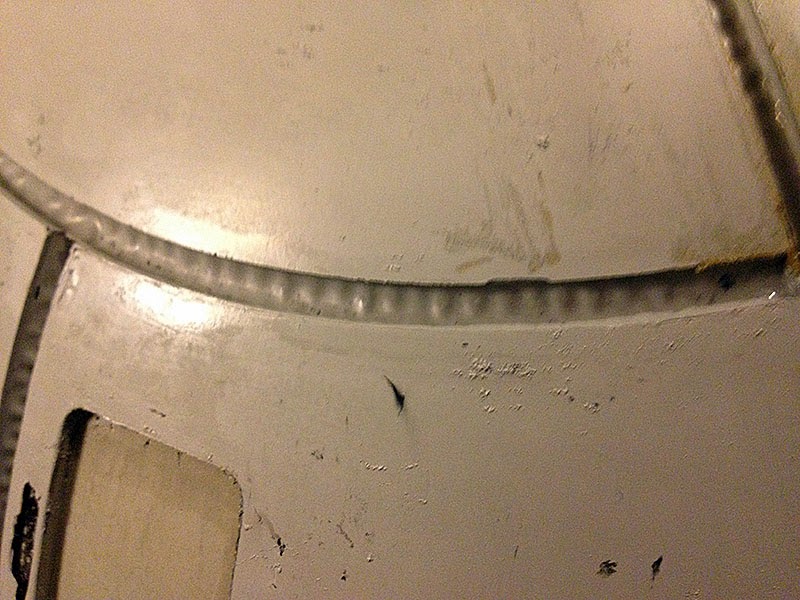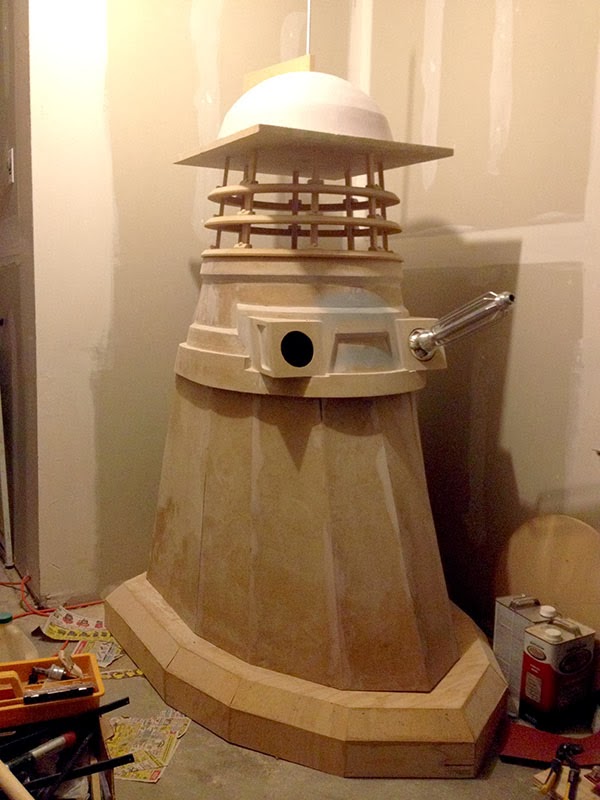
On Sunday, I decided to clean up the dome mold and sand down a few of the rough spots. After thoroughly washing off the release wax and drying it off, I wet-sanded with 320, 400, 600, and 1000-grit paper. The original luster is now slightly muted, but that won't matter. I wanted to get to drawing in the lines and other details of the mold on a clean surface.
Part of that detailing were the four dome inserts. I found some rubber sheets in plumbing section of Lowe's, which measured 2mm thick, and bought them on the spot, along with some spray adhesive. Following the plans, I had those parts drawn and cut out in short order.
Among my other purchases, I got some washers, bolts, wingnuts, and hex nuts. I also got some paint: Valspar Brilliant Gold (465-66009) and Rust-oleum Universal Aged Copper. I wanted to make a prototype hemi and decide if the gold was what I wanted to go for.
I also got to try my 3.5" hole saw for the first time. I made several disks out of left-over HDF board, taking a note from ccain to drill an extra hole to ensure a flow of oxygen when gluing these into the hemis. I slipped a washer over a 2" 10-24 crown bolt, and inserted it through the disk. I fastened it down with another washer and a hex nut, then glued all along the edge of the disk with Liquid Nails.
To make sure that everything was perfectly perpendicular, I drilled a hole into some scrap MDF, which the bolt fit through perfectly, and secured it with a wingnut (which is what I'll be using to secure the hemis into the skirt section once I get that far).
While that was going on, I decided to use a separate hemi to experiment with the paint. Laying down some newspaper and opening up the garage door, I sprayed on a couple of coats of primer, letting each dry for about 20 minutes or so. Then, I did about three coats of the gold paint. I must say, it's pretty pleasing to the eye.
While the paint was drying, I cut out the rest of the dome inserts, and when those were done (and I had taken a slight gaming break), the paint was also finally dry. I placed the gold hemi into an oil seal, and voilà!
Now that I had the inserts, the next step was to draw all the lines onto the concave surface of the mold. And man, I spent a long time with this step. I don't know if there's a fast and easy trick to drawing straight lines on a curve. I mostly had to eyeball it. So first, I ran across the circular cut-out section of my largest neck ring, and placed it within the mold. It conveniently had pencil lines dividing it into eighths, pointing—in its case—to where the neck struts were to have been cut out.
This was a great starting point. After using a ruler to make sure that the cut-out was equidistant from the chamfer line of the mold on all sides, I started making marks in wet-erase marker.
Then, I cut a very thin strip of thick card stock and put it down on the meridian of the mold, leaving about 3 inches or so sticking up past the mold lip. I took my protractor to make sure that the card strip was 90° (perpendicular) to the mold base, then taped it into place. Then, I repeated that on the other side.
Next came the eyeballing part. Using every ounce of scrutiny I could muster, I tried to ensure that the part of the card strip that was following the curve of the dome was in a completely straight line. I then traced along one side with my marker. I then repeated that three more times for the remaining lines. From the center-point, I make marks on each line where the circumference of the D-shaped half-circle groove would go. I happened to have a plate that was pretty close to that size, so I traced around it.
After that, I held the inserts into position and gently traced around them so that I knew where to place them once I sprayed on the adhesive. I'll do that later, once the 6mm chrome half-round wheel trim arrives.

For all intents and purposes, it came out surprisingly accurate. Looking at it doesn't trigger anything "off" to my eyes, anyway. One thing I did have a bit of trouble with was deciding where to put the front groove lines. According to the plans, there's a 12cm groove line starting at an unspecified angle from the eye stalk hole, connected to a 5cm groove line on another unspecified angle, which then connects to a groove perpendicular to the dome mold chamfer. Assuming we call the chamfer groove's angle 90°, I drew the 5cm 65° from it. Then I just eyeballed the remaining line until it equaled 12cm and touched the eye stalk hole. Repeat for the other side.

Also, before I decided to buy the wheel trim for the grooves, I experimented with applying beads of flexible caulk onto wax paper. I found that one of my microwave plate covers was pretty close to the circumference I needed for the D-shaped groove, so I applied a bead of caulk around it. Then, I gently pulled the cover away, and put another piece of wax paper on top to smooth out the jerky line.
I also had the idea to drill half a hole into one of my filler spreaders. I tried to make a uniform half-circle along the bead, but I wound up squishing the whole mess into itself. My inner perfectionist kicked in, wadded up all the work, and threw it into the bin. Then I plunked money down on the chrome trimming.
Anyway, once that wheel trim comes in, I'll start laying it all out, putting in the inserts, and getting ready for casting the DOME!
 I've place another order for more chrome wheel trim for the dome like I used last time, as I was only left with enough to make the dome's one full-bisecting line, and nothing more. I've also got some repair to do to the mold, where some of the gray gel-coat is pretty solidly stuck to it. I'll need to take out the inserts that were left behind, and give everything a good sanding, cleaning, and polishing.
I've place another order for more chrome wheel trim for the dome like I used last time, as I was only left with enough to make the dome's one full-bisecting line, and nothing more. I've also got some repair to do to the mold, where some of the gray gel-coat is pretty solidly stuck to it. I'll need to take out the inserts that were left behind, and give everything a good sanding, cleaning, and polishing. Nothing much to report today, though it was a full day, regardless. I finished off cutting 56 3.5" disks for my hemispheres using the hole cutter, added the extra ventilation hole for glue curing, and then put bolts, washers, and nuts into 50 of them, torquing them tight. I accidentally only bought two packs of 25 bolts each, thinking I was buying two packs of 50. So oops, I ran out!
Nothing much to report today, though it was a full day, regardless. I finished off cutting 56 3.5" disks for my hemispheres using the hole cutter, added the extra ventilation hole for glue curing, and then put bolts, washers, and nuts into 50 of them, torquing them tight. I accidentally only bought two packs of 25 bolts each, thinking I was buying two packs of 50. So oops, I ran out! I also glued 16 of them, enough for the front four skirt panels. I wore a latex glove to finger-smear around the edge to work the glue (Liquid Nails) in. Once they're all cured, I'll attach them. I'm waiting on painting everything because of the limited space in my garage, and I don't want to scrape or bump into paint while I'm working. I'll trim the extra bits of plastic off of them later.
I also glued 16 of them, enough for the front four skirt panels. I wore a latex glove to finger-smear around the edge to work the glue (Liquid Nails) in. Once they're all cured, I'll attach them. I'm waiting on painting everything because of the limited space in my garage, and I don't want to scrape or bump into paint while I'm working. I'll trim the extra bits of plastic off of them later.







































